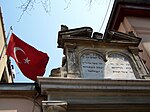Prinkipo Greek Orthodox Orphanage
1898 establishments in the Ottoman Empire7 Most Endangered ProgrammeBuildings and structures in IstanbulGreece–Turkey relationsGreeks from the Ottoman Empire ... and 4 more
Greeks in TurkeyHistoric sites in TurkeyOrphanages in TurkeyWooden buildings and structures in Turkey

The Prinkipo Greek Orphanage (Turkish: Prinkipo Rum Yetimhanesi, also known as Prinkipo Palace or Büyükada Greek Orphanage) is a historic 20,000-square-meter wooden building on Büyükada, one of the nine Princes' Islands off the coast of Istanbul, Turkey, in the Sea of Marmara. It is considered the largest wooden building in Europe and second largest in the world. It served as an orphanage from 1903 to 1964.
Excerpt from the Wikipedia article Prinkipo Greek Orthodox Orphanage (License: CC BY-SA 3.0, Authors, Images).Prinkipo Greek Orthodox Orphanage
Çarkıfelek Caddesi,
Geographical coordinates (GPS) Address External links Nearby Places Show on map
Geographical coordinates (GPS)
| Latitude | Longitude |
|---|---|
| N 40.860833333333 ° | E 29.123333333333 ° |
Address
Büyükada Eski Rum Yetimhanesi
Çarkıfelek Caddesi
34970 , Maden Mahallesi
Turkey
Open on Google Maps








